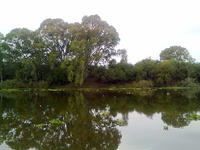You are in: Africa -> South Africa -> Vredefort Dome, and traditional search or Image Gallery will yield results of this site only
Vredefort Dome
| Site number: | 1162 |
|
| Type of site: | Natural | |
| Date: | 2,023 mill.yrs | |
| Date of Inscription: | 2005 | |
| Location: | Africa, South Africa, Northwest and Free State provinces | |
Up to 75 images are shown here. Click on each for more details or on Image Gallery for more images.
| Description: | Approximately 120km south west of Johannesburg, Vredefort Dome is an illustrative component of a larger meteorite collision formation (astrobleme). Today it is earth’s oldest known astrobleme, dating back 2,023 million years, as well as its largest and most deeply eroded with a radius of 190km. The world’s greatest acknowledged single energy release occurred in the Vredefort Dome, which triggered destructive global change, including, on the word of some scientists, major evolutionary changes. It supplies significant evidence of the earth’s geological history and is fundamental to our insight of the planet’s evolution. In spite of their meaning within the planet’s history, the earth’s surface has seen geological activity that has led to the disappearance of evidence from nearly all impact sites; Vredefort is the earth’s sole example to present a complete geological sketch of an astrobleme underneath the crater floor. --WHMNet paraphrase from the description at WHC Site, where additional information is available. | |
| Vredefort crater is the largest verified impact crater on Earth. It is located in the Free State Province of South Africa, and named after the town of Vredefort, which is situated near its centre. The site is also referred to as Vredefort dome or Vredefort impact structure. In 2005, the Vredefort Dome was added to the list of UNESCO World Heritage Sites for its geologic interest. The asteroid that hit Vredefort is one of the largest to ever impact Earth, estimated at over 10 km (6 miles) wide, although it is believed by many that the original size of the impact structure could have been 250 km in diameter, or possibly larger. This makes Vredefort the largest known impact structure on Earth (though the Wilkes Land crater in Antarctica, if confirmed to have been the result of an impact event, is even larger at 500 kilometers across). The crater has a diameter of roughly 300 km (186 miles), larger than the 250 km (155 miles) Sudbury Basin, and the 170 km (106 miles) Chicxulub crater. The age is estimated to be over 2 billion years (2023 ± 4 million years), impacting during the Paleoproterozoic era. It is the second oldest known crater on the Earth, a little less than three hundred millions years younger than the Suavjärvi crater in Russia. It was originally thought that the dome in the center of the crater was formed by a volcanic explosion, but in the mid 1990s evidence revealed that it was the site of a huge bolide impact, with telltale shatter cones often discovered in the bed of the nearby Vaal River. The Vredefort crater site is one of the few multi-ringed impact craters on Earth, though they are more common elsewhere in the solar system. Perhaps the best example is of Valhalla crater on Jupiter's moon Callisto, though Earth's Moon has a number as well. Geological processes, such as erosion and plate tectonics, have destroyed most multi-ring craters on Earth. The nearby Bushveld Igneous Complex (BIC) was created during this same period, leading to speculation that Vredefort impactor size/kinetics were of sufficient magnitude to induce local volcanism. BIC is the location of the majority of world's known reserves of platinum group metals (PGMs). --Wikipedia. Text is available under the Creative Commons Attribution-ShareAlike License. | ||
| Source: | http://whc.unesco.org/en/list/1162 | |
| Reference: | 1. UNESCO World Heritage Center, Site Page. | |
















